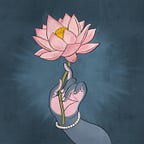The Cow that Attained Salvation at Govindaputtur
Within a cavelike niche formed by the billowing, bifurcated tongue of a beautiful kīrtimukha, a cow shelters a Śivaliṅga even as she licks it in adoration. Two heraldic lions stand on their hind legs like sentinels at the bottom of the arch, and several others parade above as if they are climbing a cave. At the lower right a dwarf rides a makara; the same motifs, now broken away, were probably also present on the opposite side. This granite relief, depicting a fairly unusual theme, probably once served as a tympanum in a Śaiva temple. The relief likely represents a local legend associated with the village Govindaputtur on the northern bank of the river Kollidam (Coleroon) in Tamil Nadu. An ancient Śaiva shrine, it was visited by Appar and Sambandar, two important Śaiva saints and hymnists who lived in the seventh century. Both visited the temple at Govindaputtur, and recorded the local tradition of a cow attaining salvation at Govindaputtur by adoring the Śivaliṅga of the local temple known as Tiru-Vijayamaṅgai. Hence the place became known as Govindaputtur, “the cow’s salvation place.” This relief shows the cow at worship, curving her shape devoutly around a liṅga and licking it as if it were her calf. The cow is framed within a false dormer window (kudu), which was part of a cornice molding (kapota).
Such kudus punctuate the cornice molding of a temple at regular intervals. The kudu is framed by an arch (makara-tōraṇa) filled with figures of various animals. A makara, or crocodile-like mythical monster of the deep sea, is seen at the springing of the arch emitting from its jaws, or swallowing, a leonine beast (śārdūla). From the shade of the framing border emerges the cow, her body carved in intersecting planes. A large eight-petaled flower graces her forehead. The linga emerges from a conspicuous yoni, or “womb” pedestal.
The provenance of this granite relief is difficult to determine. Its style is closely related to those of sculptures in the Śiva temple at Kalugumalai. Known locally as Vettuvankoil, this temple was excavated from live rock probably during the reign of Varugana I, one of the great kings of the Pandya dynasty, who ruled from 765 until 815. The district of Tinnevelly was within the Pandya Kingdom about 800. Although the monuments created by their rivals, the Pallavas, are better known, architecture and sculpture also flourished in the Pandya Kingdom. The sculptor of this fascinating relief obviously delighted in rendering animals. His unfamiliarity with the lion is obvious; although animated, the animals appear like puppies, especially in contrast to the much larger cow. The bovine form has been realised with utmost economy, yet the representation is remarkably naturalistic as is evident by the turn of the animal’s neck and the arch of the back.
Sources:
Pal, P. (1986). Indian Sculpture: Circa 500 B.C.-A.D. 700. United Kingdom: Los Angeles County Museum of Art
Manifestations of Shiva by Kramrisch, Stella
________________________________________________________________
If you find value in my work, I hope you consider becoming a patron or making a contribution to hindu.aesthetic@okicici. Hindu Aesthetic requires a lot of time and effort and your support would mean that I can continue bringing you the best possible content. ❤
